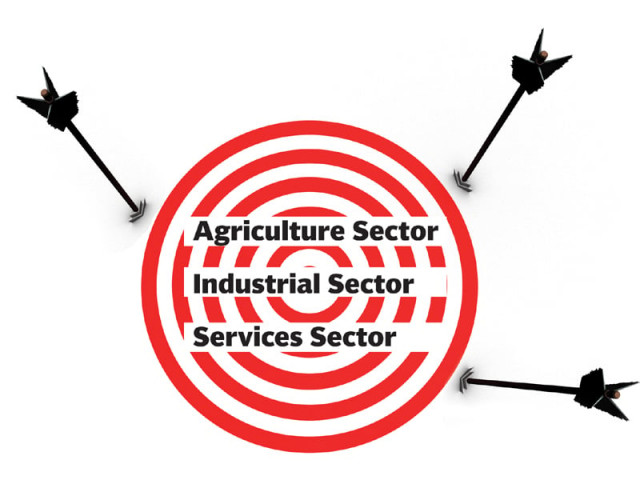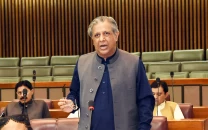The verdict is in: Nation misses most targets for economic growth
GDP growth for fiscal 2012-13 will clock in at 3.59% against the target of 4.3%.

Average annual GDP growth rate over the previous government’s tenure remains 2.9%, highlighting failures in economic management. DESIGN: ANAM HALEEM
The current fiscal year will go down in history as yet another year of missed opportunities: the country’s economy grew only 3.6% during the year, far below official targets but in line with projections made by international financial institutions. A net Rs341.2 billion was added to the nation’s economy this year, according to the data available.
The National Accounts Committee revealed on Friday that GDP growth for fiscal 2012-13 will clock in at 3.59% against the target of 4.3%. The estimate is based on extrapolations of provisional information available for the first nine months of the ongoing fiscal year, which ends on June 30. The projections were made keeping 2005-06 as the base year, following the Pakistan Bureau of Statistics’ recent rebasing exercise. The NAC said growth would have clocked in at a much lower 3.2% had the old base year of 1999-00 been used.
The average annual growth rate of the economy over the five-year tenure of the PPP-led coalition thus remains very low at only 2.9%, highlighting failures in economic management.
The 3.6% growth rate even falls below the growth rate of 4.4% achieved last fiscal year (the NAC had revised the growth estimates of the previous year upwards after it received final production figures). This declining trend in the growth rate of national output is contrary to claims made by the previous economic team, led by former finance minister Dr Abdul Hafeez Shaikh, which had declared a victory for itself – professing that the growth rate was increasing every year.
“Energy was the biggest bottleneck to growth, but resolution of the issue remained the last priority of the government,” Pakistan Bureau of Statistics’ Chief Statistician Asif Bajwa observed.
Various official and independent studies have repeatedly suggested in recent months that national output has to be increased by 7-8% annually to absorb the two million new entrants entering the jobs market every year.
Bajwa explained that public consumption figures have been worked out on the basis of budget estimates. The NAC has accounted for only Rs185 billion for power subsidies for the current fiscal year while working out growth in the sub-sectors of electricity generation, distribution and gas distribution. Had the NAC taken actual power subsidies into account, growth in this sub-sector would have been negative. As of now, it seems likely that power subsidies will cross Rs350 billion by end June.
Agriculture sector
The agriculture sector grew only 3.4% as against the target of 4% according to the NAC. The targets set for sub-sectors of major and minor crops were surpassed, while those for livestock, forestry and fisheries were missed.
Among the five major crops, the targets for three crops were missed, the exceptions being maize and sugarcane. Wheat production remained at 24.3 million tons against a target of 25.5 million tons; similarly, rice production remained at 5.5 million tons against a target of 6.9 million tons. The production of cotton bales clocked in at just 6.6 million bales as against the target of 14.5 million bales. On a positive note, sugarcane production came to around 62.5 million tons, against the target of 59 million tons, while maize production stood at 4.7 million tons, against the target of 4.3 million tons.
Industrial sector
The industrial sector output growth target of 3.8% was also missed, with the sector growing 3.5% during the year. NAC members have, however, raised objections over the phenomenal growth of 8.3% seemingly witnessed in the small and medium enterprises sector, as they say this sector was hit hardest by the energy crisis. Large scale manufacturing, meanwhile, grew 2.83%, slightly above targets.
Negative growth of 3.6% in electricity, gas and water supply sub-sectors took the average down, even though the construction sector also grew 5.2%. NAC members have also raised questions over the use of 1980s coefficients for measuring growth in the construction sector.
The growth rate of the mining and quarrying sector clocked in at a healthy 7.6%, against a target of 3%.
Services sector
The services sector output growth target of 4.6% was also missed, and the biggest component of the economy grew by only 3.7%. The wholesale and retail sector grew 2.5%, transport and storage 3.5%, finance and insurance 6.6%, housing services 4% and general government services by 5.6% on the back of increases in employees’ salaries.
Published in The Express Tribune, May 4th, 2013.
Like Business on Facebook to stay informed and join in the conversation.



















COMMENTS
Comments are moderated and generally will be posted if they are on-topic and not abusive.
For more information, please see our Comments FAQ